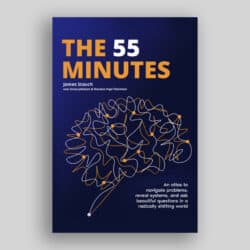The COVID-19 pandemic has tested the resilience of many organizations. In their practical and timely book, Dennis Young and Elizabeth Searing take the opportunity to look at the larger question of preparedness in sector groups for dealing with circumstances – society-wide or unique to a specific organization – that threaten their viability.
Resilience and the Management of Nonprofit Organizations: A New Paradigm, by Dennis R. Young and Elizabeth A.M. Searing. Edward Elgar Publishing, 2022; hardcover, 192 pp; ISBN 978 1 80088 972 9.
Dennis Young and Elizabeth Searing are both American academics, and their book Resilience and the Management of Nonprofit Organizations: A New Paradigm focuses on the U.S. They begin their analysis by critiquing the “minimize overhead, diversify resources, be lean, and avoid debt” shorthand that is often seen as the optimal management path to maintaining an organization’s trustworthiness and by seeking to define “efficiency” in broader terms than it is sometimes understood. They argue that a healthier approach, which would better enable organizations to survive crises, entails grounding management decisions in a wider perspective and better taking into account what is apt to happen over the long term.
It is impossible to anticipate every contingency, but the book highlights the need to embed planning for disruption of some sort into management processes.
They begin by examining types of risk faced by non-profit organizations, their probability, and the severity of their consequences. In 2022, the world in which non-profits – whether grassroots groups or institutions – operate is fraught with financial, environmental, reputational, and other risk. In some instances, such as the pandemic and the 2008 economic downturn, groups across the sector may be affected, while in other cases, the impact may be confined to a single group or to groups within a sub-sector of the non-profit world. Similarly, probability and severity may vary widely between incidents.
It is impossible to anticipate every contingency, but the book highlights the need to embed planning for disruption of some sort into management processes. Crucial aspects of understanding and coping with risk are dealt with in the following two chapters. The authors tackle the problem of probability and then propose a “what if” scenario approach to position groups to handle crises when they arise. Then they delve into the academic literature on organizational “slack” – essentially, the structural inefficiencies and unused capability that develop through happenstance in any entity that doesn’t face stiff competition or other stresses – and argue the value of the capacity and potential available from “slack” as a buffer against unforeseen events and as a cornerstone of resilience.
The following chapters offer a primer on non-profit accounting and, more broadly, on how economic factors affect organizational behaviour and decision-making. While some of this material is quite basic, a sound understanding of this framework is needed to build the kind of management strategy the authors advocate.
Unfortunately, the book does not address some of the shortcomings faced by non-profit groups in an environment where systems have often been designed or function with the sector as an afterthought, rather than featuring bespoke solutions suited to the unique and special nature of organizations operating for public or member benefit. One recent example of this is Laurentian University administration’s use of the Companies’ Creditors Arrangement Act (CCAA) to stave off insolvency.
Relying on a statutory instrument designed primarily for for-profit entities to restructure an institution with the range of stakeholders and diverse constituencies of a university was widely criticized and led to legislative efforts to avoid future use of the CCAA in similar circumstances.
This is far from the only situation in which the sector is compelled to try to fit a square peg in a round hole. It was presumably beyond the remit of Young and Searing to address this type of issue, but non-profits might have different or better escape valves if, when facing threats to their existence, some of these structural deficiencies were corrected.
In their three chapters focusing on assets and liabilities, cost structure, and income portfolios, the authors offer useful tips and examples of approaches to devoting resources to fixed versus variable costs and of the traps of depending on income limited to restricted uses. And, in the following chapter, they provide useful suggestions on leveraging technology to increase organizational resilience.
The chapter “People and Resilience” tackles the thorny subject of balancing paid staff and volunteer labour and provides some helpful analysis and tools in assessing the advantages and disadvantages of opting for one or the other to accomplish particular types of work.
Beyond routine operations, two further keys to resilience are identified by the authors: entrepreneurship and networks.
Given current demographics, it would have been interesting if Young and Searing had further explored the potential of technology in the realm of non-profit labour needs. With chronic staffing shortages in some areas of health and social services, might the resilience of the groups working in this field be improved by potential technological solutions for enhancing their front-line capacity and better meeting needs?
Beyond routine operations, two further keys to resilience are identified by the authors: entrepreneurship and networks. Entrepreneurship entails an increase in lateral thinking and a greater willingness for risk-taking in non-profits. A number of examples are given of organizations branching out from or re-envisioning their programs or activities to make them available to a new constituency. Instances of cultural organizations moving programming online during the pandemic, and extending their audiences by doing so, are common. In some cases, organizations took a chance by launching the initiative, and converting it to a revenue stream only at a later date. This type of daring is not always seen among sector groups.
Young and Searing then explore networks, and their potential as supports for front-line organizations. They discuss the dynamics of these types of relationships and observe that they may not be as one-sided as they appear at first. There is a happy tradition in the sector of a willingness by better-resourced groups to share expertise and knowledge with their smaller counterparts. The authors stress the importance of not losing sight of less formal connections from which groups and their personnel can gain insights and information, as well as the value of more formal arrangements where organizations may be able to access back-office services or find other structural supports (especially when they are in crisis).
The next-to-last chapter features “red flags” and “stress tests” and provides templates for positioning an organization to cope with crises. The authors advocate for tools both to alert the group’s governing body and management to emerging or realized risks and for showing that the organization is prepared to deal with potential or actual threats. Also suggested is stress-testing to assess organizational resilience. These proposed mechanisms are thoughtfully designed and, subject to being adapted to the particulars of individual groups, are worthwhile and valuable.
The challenge is that with time and resources in so many – especially so many smaller – organizations being at a premium, implementation of this kind of documentation and pro-active thinking is likely, at best, aspirational. The authors acknowledge in their concluding chapter the significant scope of what they are proposing. They also, tellingly, note the change in the mindset of funders, rating agencies, and others needed to allow groups to operate within the new paradigm they propose. So, it is a bit of a heavy lift. But this book represents an excellent start.


